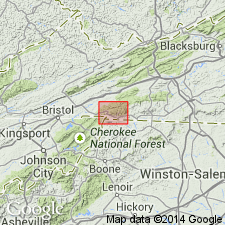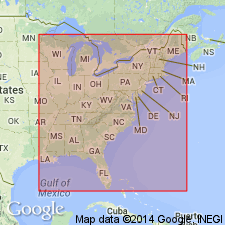
- Usage in publication:
-
- Wills Ridge Formation*
- Modifications:
-
- Age modified
- AAPG geologic province:
-
- Piedmont-Blue Ridge province
Summary:
Age changed to Late Proterozoic to Cambrian following work of Whisonant and Tso (1992, Field trip number 2, stratigraphy and structure of the lower Ashe Formation (upper Precambrian) along the Fries fault in southwestern Virginia, IN Geologic field guides to North Carolina and vicinity: University of North Carolina at Chapel Hill, Department of Geology, Geologic Guidebook 1, p. 15-28). Juxtaposition of Wills Ridge and Ashe is thought to be along a thrust fault. Age of Wills Ridge is poorly constrained, but is bracketed between Middle Proterozoic Grenvillian basement and Ordovician Taconian closing of Iapetus Ocean. Whisonant and Tso (1992) concluded that Wills Ridge Formation (their "lower Ashe Formation") was deposited in subaqueous parts of fan or braid deltas that prograded into relatively deep water on Laurentian crust. Whether absence of ultramafic bodies in Wills Ridge is because depositional site was on Laurentian margin or because age of deposits is predrift is not known. For these reasons, age is changed.
Source: GNU records (USGS DDS-6; Reston GNULEX).

- Usage in publication:
-
- Wills Ridge Formation*
- Modifications:
-
- Named
- Dominant lithology:
-
- Phyllite
- Metasiltstone
- Metagraywacke
- Metagrit
- Metaconglomerate
- Greenstone
- AAPG geologic province:
-
- Piedmont-Blue Ridge province
Summary:
Named for Wills Ridge, Floyd Co., southwestern VA. Includes rocks previously mapped as Ashe Formation by Espenshade and others (1975); Ashe is now restricted to those rocks in Jefferson terrane stratigraphically(?) below Alligator Back Formation. Exposed on and northwest of Wills Ridge. Consists of phyllite, metasiltstone, metagraywacke, metagrit, metaconglomerate, and greenstone; does not include ultramafics. Separated from Ashe by thrust fault and thought to be stratigraphically tied to Laurentia. Includes pelitic rocks of up to 3 km in outcrop width that include Alum Phyllite and Willis Phyllite of Dietrich (1959). Basal contact with Little River Gneiss of Dietrich (1959) was not observed during reconnaissance mapping. Age is Late Proterozoic. Report includes geologic maps, correlation chart, and isotopic data.
Source: GNU records (USGS DDS-6; Reston GNULEX).
For more information, please contact Nancy Stamm, Geologic Names Committee Secretary.
Asterisk (*) indicates published by U.S. Geological Survey authors.
"No current usage" (†) implies that a name has been abandoned or has fallen into disuse. Former usage and, if known, replacement name given in parentheses ( ).
Slash (/) indicates name conflicts with nomenclatural guidelines (CSN, 1933; ACSN, 1961, 1970; NACSN, 1983, 2005, 2021). May be explained within brackets ([ ]).

